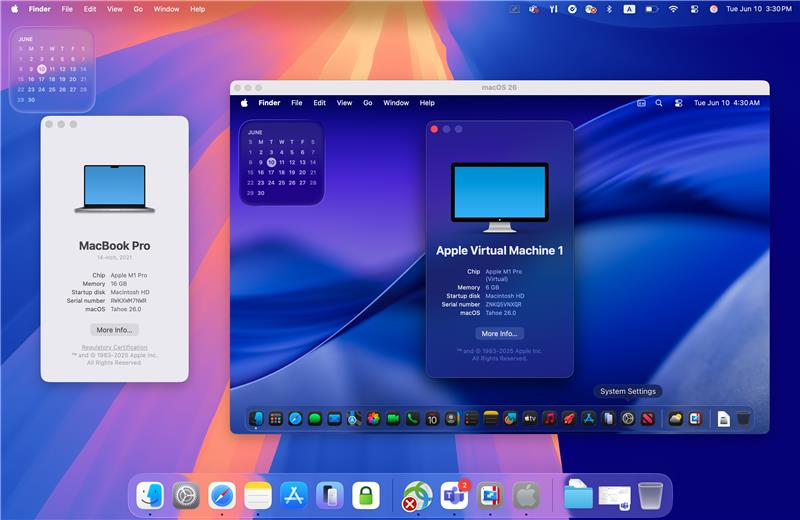
WWDC 2025 in review: What Apple’s announcements could mean for Parallels Desktop users
Apple’s WWDC 2025 just wrapped up—and for IT admins, Mac fans, and power users running Windows on Mac with Parallels Desktop, this isn’t just another keynote or product showcase.
This conference offers a first look at what’s new from Apple—including macOS 26 Tahoe—and provides a pulse check on macOS compatibility, performance on the latest Apple silicon, and the newest AI and Apple Intelligence features, integrations, and updates.
For organizations relying on Parallels Desktop to run Windows applications in macOS environments, Apple’s announcements around new chips, macOS updates, and platform changes are critical signals.
All the WWDC 2025 Apple announcements, recapped
The big news of WWDC 2025 was the introduction of Apple’s new “Liquid Glass” and the alignment of all the OS names with the calendar year, starting with 26.
The UI of iOS 26, iPadOS 26, macOS 26 (a.k.a. Tahoe), watchOS 26, tvOS 26, and visionOS 26 all get the immersive Liquid Glass treatment.
Apple Intelligence is further integrated in the new OSs, system apps, and workflows, with improved Genmoji creation, Image Playground enhancements, and smarter Shortcuts.
In addition, translation is becoming even more embedded in the Mac ecosystem, with messages getting live translation for both incoming and outgoing texts plus FaceTime will include live captioning with real-time transcriptions.
A new Games app centralizes the Mac gaming library, features social tools, and introduces an in-game overlay for chat and invites. Developers gain access to Metal 4, which delivers better performance through Frame Interpolation and denoising.
Introducing: Tahoe, the new macOS 26
The highly anticipated new macOS 26, Tahoe, is refined by Apple’s new Liquid Glass visuals.
This is a significant design shift, with the Dock, menu bars, app icons, and widgets all featuring the Liquid Glass aesthetic.
Essentially, macOS Tahoe users will be able to theme their Macs like their iPhones with customized backgrounds including color-matched folders, tinted icons, and more that match one’s chosen accent color.
Tahoe also features an overhauled Spotlight. Quick actions like writing emails or notes are supported, and you can launch apps, run shortcuts, and make inline commands. Search results are now ranked by relevance, and smart filtering has been added so you can drill down even more.
There’s full Phone app, Games app hub, and Live Activity support on the menu bar for iPhone alerts, so you’ll be able to take calls, listen to or read transcribed voicemails, and otherwise get all your alerts and notifications right on your Mac. The Journal App has also been added to Mac and iPad, so you can write down your thoughts, draw, and doodle using Apple Pencil.
| Feature | What you experience |
| Liquid Glass UI | Fresh, customizable look across macOS |
| Spotlight overhaul | Search + action + app launcher, all-in-one |
| Phone app on Mac | Better continuity and seamless call handling |
| Live translations + captions | Multi-language communication made easy |
| AI enhancements | More Apple Intelligence tools at your fingertips |
| Journal App | Coming to Mac and iPad |
| Games app + Metal 4 | Developers and gamers get richer Mac support |
| New versioning | Cleaner OS version numbering |
Get started running macOS 26 Tahoe in a virtual machine
Whether you’re a developer or enthusiast, you can already run the new macOS Tahoe Developer Beta in a virtual machine using Parallels Desktop. It’s great for testing and exploration and here’s how to do it.
Running Parallels Desktop on macOS Tahoe
The Parallels Desktop team is also testing Parallels Desktop on a Mac running macOS 26 Tahoe Developer Beta. The early results are promising, and we are actively addressing a few compatibility items to ensure the best possible experience in upcoming updates.
From compliance and compatibility to deployment and performance, IT leaders need to understand how shifts in Apple’s ecosystem could impact cross-platform workflows and virtualization strategies.
Whether you’re managing remote teams, supporting legacy apps, or building a flexible Mac + Windows ecosystem, WWDC is your early look at what’s coming—and how to stay one step ahead with Parallels Desktop.
When can I try macOS 26 Tahoe for myself?
Developer beta is live today (June 2025), with a public beta coming next month and the final release scheduled for fall 2025.
If you already have a Mac equipped with Parallels Desktop, you can test the new OS! Here’s how to install macOS Tahoe on a Mac running Sequoia.
What Macs support macOS 26 Tahoe?
It’s supported on all Apple silicon Macs—and select Intel models equipped with T2 chips (roughly 2020 and newer).
Future macOS versions—starting with macOS 27—will no longer support Intel-based Macs, meaning older Macs like the 2017 iMac Pro, 2018 Mac Mini, and certain pre-2020 MacBook Pro/Air models will not be supported.
What does this mean for Parallels Desktop users?
Parallels Desktop users can continue to enjoy the best of both worlds and run Windows alongside the new Tahoe macOS 26 when it’s available.
As always, our engineers are carefully evaluating the new features and frameworks introduced at WWDC.
If there’s something specific from WWDC that you’d love to see in Parallels Desktop, we’d love to hear it. Share your ideas with us on our forums and via your MyParallels account.
Experience all the new features and updates on your Mac equipped with Parallels Desktop
If you already know and love running Windows on Mac with Parallels Desktop, then you can rest assured knowing that you’ll continue to enjoy all your favorite Windows and macOS features plus the latest in macOS 26 when it’s released to the general public.


